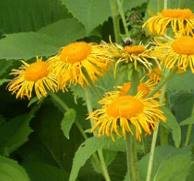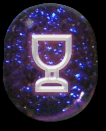Elecampane
Elecampane is a tall, stout, downy plant, from three to five feet high, of the Composite order, with broad leaves, and bright, yellow flowers. Campania is the original source of the plant (Enula campana), which is called also Elf-wort, and Elf-dock.
Added Jul 11, 2010
| 6,027 Reads
"Elecampane," writes William Coles, "is one of the plants whereof England may boast as much as any, for there grows none better in the world than in England, let apothecaries and druggists say what they will." Elecampane is a tall, stout, downy plant, from three to five feet high, of the Composite order, with broad leaves, and bright, yellow flowers. Campania is the original source of the plant (Enula campana), which is called also Elf-wort, and Elf-dock. Its botanical title is Helenium inula, to commemorate Helen of Troy, from whose tears the herb was thought to have sprung, or whose hands were full of the leaves when Paris carried her off from Menelaus. This title has become corrupted in some districts to Horse-heal, or Horse-hele, or Horse-heel, through a double, blunder, the word inula being misunderstood for hinnula, a colt; and the term Hellenium being thought to have something to do with healing, or heels; and solely on this account the Elecampane has been employed by farriers to cure horses of scabs and sore heels. Though found wild only seldom, and as a local production in our copses and meadows, it is cultivated in our gardens as a medicinal and culinary herb. The name inula is only a corruption of the Greek elenium; and the herb is of ancient repute, having been described by Dioscorides. An old Latin distich thus celebrates its virtues: Enula campana reddit proecordia sana—"Elecampane will the spirits sustain." "Julia Augusta," said Pliny, "let no day pass without eating some of the roots of Enula condired, to help digestion, and cause mirth." The inula was noticed by Horace, Satire viii., 51:— "Erucos virides inulas ego primus amaras Also the Enula campana has been identified with the herb Moly (of Homer), "apo tou moleuein, from its mitigating pain." Prior to the Norman Conquest, and during the Middle Ages, the root of Elecampane was much employed in Great Britain as a medicine; and likewise it was candied and eaten as a sweetmeat. Some fifty years ago the candy was sold commonly in London, as flat, round cakes, being composed largely of sugar, and coloured with cochineal. A piece was eaten each night and morning for asthmatical complaints, whilst it was customary when travelling by a river to suck a bit of the root against poisonous exhalations and bad air. The candy may be still had from our confectioners, but now containing no more of the plant Elecampane than there is of barley in barley sugar. Gerard says: "The flowers of this herb are in all their bravery during June and July; the roots should be gathered in the autumn. The plant is good for an old cough, and for such as cannot breathe freely unless they hold their necks upright; also it is of great value when given in a loch, which is a medicine to be licked on. It voids out thick clammy humors, which stick in the chest and lungs." Galen says further: "It is good for passions of the huckle-bones, called sciatica." The root is thick and substantial, having, when sliced, a fragrant aromatic odour. Chemically, it contains a crystalline principle, resembling camphor, and called "helenin"; also a starch, named "inulin," which is peculiar as not being soluble in water, alcohol, or ether; and conjointly a volatile oil, a resin, albumen, and acetic acid. Inulin is allied to starch, and its crystallized camphor is separable into true helenin, and alantin camphor. The former is a powerful antiseptic to arrest putrefaction. In Spain it is much used as a surgical dressing, and is said to be more destructive than any other agent to the bacillus of cholera. Helenin is very useful in ulceration within the nose (ozoena), and in chronic bronchitis to lessen the expectoration. The dose is from a third of a grain to two grains. Furthermore, Elecampane counteracts the acidity of gouty indigestion, and regulates the monthly illnesses of women. The French use it in the distillation of absinthe, and term it l'aulnee, d'un lieu planté d'aulnes ou elle se plait. To make a decoction, half-an-ounce of the root should be gently boiled for ten minutes in a pint of water, and then allowed to cool. From one to two ounces of this may be taken three times in the day. Of the powdered root, from half to one teaspoonful may be given for a dose. A medicinal tincture is prepared from the root, of which thirty or forty drops may be taken for a dose, with two tablespoonfuls of cold water; but too large a dose will induce sickness. Elecampane is specifically curative of a sharp pain affecting the right elbow joint, and recurring daily; also of a congestive headache coming on through costiveness of the lowest bowel. Moreover, at the present time, when there is so much talk about the inoculative treatment of pulmonary consumption by the cultivated virus of its special microbe, it is highly interesting to know that the helenin of Elecampane is said to be peculiarly destructive to the bacillus of tubercular disease. In classic times the poet Horace told how Fundanius first taught the making of a delicate sauce, by boiling in it the bitter Inula (Elecampane); and how the Roman stomach, when surfeited with an excess of rich viands, pined for turnips, and the appetising Enulas acidas from frugal Campania:— "Quum rapula plenus
Added Jul 11, 2010
| 6,027 Reads
Share The Magic ...
The GoE MONEY!!! Course - A Course In Real MONEY MAGIC!
|





















